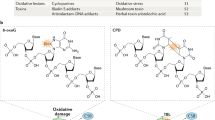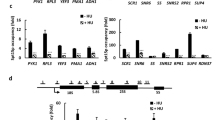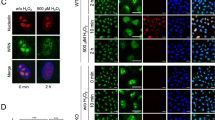Abstract
The nucleotide excision repair (NER) system consists of two subpathways, global genome repair (GGR) and transcription-coupled repair (TCR), which exhibit distinct functions in the cellular response to genotoxic stress. Defects in TCR result in prolonged UV light-induced stalling of RNA polymerase II and hypersensitivity to apoptosis induced by UV and certain chemotherapeutic drugs. Here, we show that low doses of UV trigger delayed activation of the stress-induced MAPkinase JNK and its proapoptotic targets c-Jun and ATF-3 in TCR-deficient primary human fibroblasts from Xeroderma Pigmentosum (XP) and Cockayne syndrome (CS) patients. This delayed activation of the JNK pathway is not observed in GGR-deficient TCR-proficient XP cells, is independent of functional p53, and is established through repression of the JNK-phosphatase MKP-1 rather than by activation of the JNK kinases MKK4 and 7. Enzymatic reversal of UV-induced cyclobutane pyrimidine dimers (CPDs) by CPD photolyase abrogated JNK activation, MKP-1 repression, and apoptosis in TCR-deficient XPA cells. Ectopic expression of MKP-1 inhibited DNA-damage-induced JNK activity and apoptosis. These results identify both MKP-1 and JNK as sensors and downstream effectors of persistent DNA damage in transcribed genes and suggest a link between the JNK pathway and UV-induced stalling of RNApol II.
This is a preview of subscription content, access via your institution
Access options
Subscribe to this journal
Receive 50 print issues and online access
$259.00 per year
only $5.18 per issue
Buy this article
- Purchase on Springer Link
- Instant access to full article PDF
Prices may be subject to local taxes which are calculated during checkout







Similar content being viewed by others
References
Abrahams PJ, Houweling A, Cornelissen-Steijger PDM, Jaspers NGJ, Darroudi F, Meijers CM, Mullenders LHF, Filon R, Arwert F, Pinedo HM, Natarajan APT, Terleth C, van Zeeland AA and van der Eb AJ . (1998). Mut. Res-DNA Repair, 407, 189–201.
Abrahams PJ, Houweling A and van der Eb AJ . (1992). Cancer Res., 52, 53–57.
Abrahams PJ, van der Kleij AAM, Schouten R and van der Eb AJ . (1988). Cancer Res., 48, 6054–6057.
Alessi DR, Smythe C and Keyse SM . (1993). Oncogene, 8, 2015–2020.
Bazuine M, Carlotti F, Tafrechi RSJ, Hoeben RC and Maassen JA . (2004). Mol. Endocrinol., 18, 1697–1707.
Behrens A, Sibilia M and Wagner EF . (1999). Nat. Genet., 21, 326–329.
Berneburg M and Lehmann AR . (2001). Adv. Genet., 43, 71–102.
Blattner C, Bender K, Herrlich P and Rahmsdorf HJ . (1998). Oncogene, 16, 2827–2834.
Blattner C, Kannouche P, Litfin M, Bender K, Rahmsdorf HJ, Angulo JF and Herrlich P . (2000). Mol. Cell. Biol., 20, 3616–3625.
Bossy-Wetzel E, Bakiri L and Yaniv M . (1997). EMBO J., 16, 1695–1709.
Brancho D, Tanaka N, Jaeschke A, Ventura JJ, Kelkar N, Tanaka Y, Kyuuma M, Takeshita T, Flavell RA and Davis RJ . (2003). Genes Dev., 17, 1969–1978.
Camps M, Nichols A and Arkinstall S . (2000). FASEB J., 14, 6–16.
Carlotti F, Bazuine M, Kekarainen T, Seppen J, Pognonec P, Maassen JA and Hoeben RC . (2004). Mol. Ther., 9, 209–217.
Chang LF and Karin M . (2001). Nature, 410, 37–40.
Davis RJ . (2000). Cell, 103, 239–252.
de Boer J and Hoeijmakers JHJ . (2000). Carcinogenesis, 21, 453–460.
Desbois-Mouthon C, Cadoret A, Blivet-Van Eggelpoel MJ, Bertrand F, Caron M, Atfi A, Cherqui G and Capeau J . (2000). Endocrinology, 141, 922–931.
Engelbrecht Y, de Wet H, Horsch K, Langeveldt CR, Hough FS and Hulley PA . (2003). Endocrinology, 144, 412–422.
Farooq A and Zhou MM . (2004). Cell. Signal., 16, 769–779.
Ford JM and Hanawalt PC . (1995). Proc. Natl. Acad. Sci. USA, 92, 8876–8880.
Franklin CC and Kraft AS . (1997). J. Biol. Chem., 272, 16917–16923.
Franklin CC, Srikanth S and Kraft AS . (1998). Proc. Natl. Acad. Sci. USA, 95, 3014–3019.
Guo YL, Kang BB and Williamson JR . (1998). J. Biol. Chem., 273, 10362–10366.
Hai T, Wolfgang CD, Marsee DK, Allen AE and Sivaprasad U . (1999). Gene Expression, 7, 321–335.
Hayakawa J, Depatie C, Ohmichi M and Mercola D . (2003). J. Biol. Chem., 278, 20582–20592.
Hayakawa J, Mittal S, Wang Y, Korkmaz KS, Adamson E, English C, Omichi M, McClelland M and Mercola D . (2004). Mol. Cell, 16, 521–535.
Herrlich P, Bender K, Knebel A, Bohmer FD, Gross S, Blattner C, Rahmsdorf HJ and Gottlicher M . (1999). CR Acad. Sci. III, 322, 121–125.
Jaspers NGJ, Raams A, Kelner MJ, Ng JMY, Yamashita YM, Takeda S, McMorris TC and Hoeijmakers JHJ . (2002). DNA Repair, 1, 1027–1038.
Kannan K, Amariglio N, Rechavi G, Jakob-Hirsch J, Kela I, Kaminski N, Getz G, Domany E and Givol D . (2001). Oncogene, 20, 2225–2234.
Keyse SM . (2000). Curr. Opin. Cell Biol., 12, 186–192.
Keyse SM and Emslie EA . (1992). Nature, 359, 644–647.
Kool J, Hamdi M, Cornelissen-Steijger PDM, van der Eb AJ, Terleth C and van Dam H . (2003). Oncogene, 22, 4235–4242.
Klein B, Pastink A, Odijk H, Westerveld A and van der Eb AJ . (1990). Exp. Cell Res., 191, 256–262.
Lamb JA, Ventura JJ, Hess P, Flavell RA and Davis RJ . (2003). Mol. Cell, 11, 1479–1489.
Lau LF and Nathans D . (1985). EMBO J., 4, 3145–3151.
Lei K and Davis RJ . (2003). Proc. Natl. Acad. Sci. USA, 100, 2432–2437.
Lei K, Nimnual A, Zong WX, Kennedy NJ, Flavell RA, Thompson CB, Bar-Sagi D and Davis RJ . (2002). Mol. Cell. Biol., 22, 4929–4942.
Li CH, Hu YH, Mayr M and Xu QB . (1999). J. Biol. Chem., 274, 25273–25280.
Li J, Gorospe M, Hutter D, Barnes J, Keyse SM and Liu YS . (2001). Mol. Cell. Biol., 21, 8213–8224.
Liu YS, Gorospe M, Yang CL and Holbrook NJ . (1995). J. Biol. Chem., 270, 8377–8380.
MacLaren A, Black EJ, Clark W and Gillespie DAF . (2004). Mol. Cell. Biol., 24, 9006–9018.
Martindale JL and Holbrook NJ . (2002). J. Cell. Physiol., 192, 1–15.
Mashima T, Udagawa S and Tsuruo T . (2001). J. Cell. Physiol, 188, 352–358.
Mckay BC, Becerril C and Ljungman M . (2001). Oncogene, 20, 6805–6808.
Mckay BC, Ljungman M and Rainbow AJ . (1998). Oncogene, 17, 545–555.
Mercurio F and Manning AM . (1999). Oncogene, 18, 6163–6171.
Mitchell JR, Hoeijmakers JHJ and Niedernhofer LJ . (2003). Curr. Opin. Cell Biol., 15, 232–240.
Mizuno R, Oya M, Shiomi T, Marumo K, Okada Y and Murai M . (2004). J. Urol., 172, 723–727.
Morrison DK and Davis RJ . (2003). Ann. Rev. Cell Dev. Biol., 19, 91–118.
Nakajima S, Lan L, Kanno S, Takao M, Yamamoto K, Eker APM and Yasui A . (2004). J. Biol. Chem., 279, 46674–46677.
Nateri AS, Riera-Sans L, Da Costa C and Behrens A . (2004). Science, 303, 1374–1378.
Queille S, Drougard C, Sarasin A and Daya-Grosjean L . (2001). J. Invest. Dermatol., 117, 1162–1170.
Rockx DAP, Mason R, van Hoffen A, Barton MC, Citterio E, Bregman DB, van Zeeland AA, Vrieling H and Mullenders LHF . (2000). Proc. Natl. Acad. Sci. USA, 97, 10503–10508.
Rosette C and Karin M . (1996). Science, 274, 1194–1197.
Sachsenmaier C, Radlerpohl A, Zinck R, Nordheim A, Herrlich P and Rahmsdorf HJ . (1994). Cell, 78, 963–972.
Sanchez-Perez I, Martinez-Gomariz M, Williams D, Keyse SM and Perona R . (2000). Oncogene, 19, 5142–5152.
Sanchez-Perez I, Murguia JR and Perona R . (1998). Oncogene, 16, 533–540.
Schreiber M, Baumann B, Cotten M, Angel P and Wagner EF . (1995). EMBO J., 14, 5338–5349.
Shaulian E and Karin M . (2001). Oncogene, 20, 2390–2400.
Shaulian E and Karin M . (2002). Nat. Cell Biol., 4, E131–E136.
Slack DN, Seternes OM, Gabrielsen M and Keyse SM . (2001). J. Biol. Chem., 276, 16491–16500.
Smith ML, Ford JM, Hollander MC, Bortnick RA, Amundson SA, Seo YR, Deng CX, Hanawalt PC and Fornace AJ . (2000). Mol. Cell. Biol., 20, 3705–3714.
Spivak G, Itoh T, Matsunaga T, Nikaido O, Hanawalt P and Yamaizumi M . (2002). DNA Repair, 1, 629–643.
Svejstrup JQ . (2002). Mol. Cell, 9, 1151–1152.
Todd DE, Densham RM, Molton SA, Balmanno K, Newson C, Weston CR, Garner AP, Scott L and Cook SJ . (2004). Oncogene, 23, 3284–3295.
van Dam H and Castellazzi M . (2001). Oncogene, 20, 2453–2464.
van Dam H, Duyndam M, Rottier R, Bosch A, De Vries-Smits L, Herrlich P, Zantema A, Angel P and van der Eb AJ . (1993). EMBO J., 12, 479–487.
van Dam H, Offringa R, Meijer I, Stein B, Smits AM, Herrlich P, Bos JL and van der Eb AJ . (1990). Mol. Cell. Biol., 10, 5857–5864.
van Dam H, Offringa R, Smits AMM, Bos JL, Jones NC and van der Eb AJ . (1989). Oncogene, 4, 1207–1212.
van Oosten M, Rebel H, Friedberg EC, van Steeg H, van der Horst GTJ, van Kranen HJ, Westerman A, van Zeeland AA, Mullenders LHF and de Gruijl FR . (2000). Proc. Natl. Acad. Sci. USA, 97, 11268–11273.
van Steeg H and Kraemer KH . (1999). Mol. Med. Today, 5, 86–94.
Wada T, Joza N, Cheng HYM, Sasaki T, Kozieradzki I, Bachmaier K, Katada T, Schreiber M, Wagner EF, Nishina H and Penninger JM . (2004). Nat. Cell Biol., 6, 215–226.
Weston CR and Davis RJ . (2002). Curr. Opin. Genet Dev., 12, 14–21.
Xu QH, Konta T, Nakayama KJ, Furusu A, Moreno-Manzano V, Lucio-Cazana J, Ishikawa Y, Fine LG, Yao J and Kitamura M . (2004). Free Radic Biol. Med., 36, 985–993.
Yan CH, Wang H and Boyd DD . (2002). J. Biol. Chem., 277, 10804–10812.
Acknowledgements
We thank Martijn Rabelink for assisting with lentivirus production, Axel Behrens for kindly providing the anti-phospho-Thr91-cJun antibody, and Jan Hoeijmakers, Harry Vrieling, Bert van Zeeland, Davy Rockx, Marcel Volker, Merlijn Bazuine, Peter Abrahams, and Lex van der Eb for helpful discussions. This work was supported by grants from the Netherlands Organisation for Scientific Research (NWO), the Dutch Cancer Society (KWF), and the Radiation Protection, Biomed, TMR, and RTN Programs of the European Community.
Author information
Authors and Affiliations
Corresponding author
Rights and permissions
About this article
Cite this article
Hamdi, M., Kool, J., Cornelissen-Steijger, P. et al. DNA damage in transcribed genes induces apoptosis via the JNK pathway and the JNK-phosphatase MKP-1. Oncogene 24, 7135–7144 (2005). https://doi.org/10.1038/sj.onc.1208875
Received:
Revised:
Accepted:
Published:
Issue Date:
DOI: https://doi.org/10.1038/sj.onc.1208875
Keywords
This article is cited by
-
Transcriptional Study Revealed That Boron Supplementation May Alter the Immune-Related Genes Through MAPK Signaling in Ostrich Chick Thymus
Biological Trace Element Research (2019)
-
Resting T cells are hypersensitive to DNA damage due to defective DNA repair pathway
Cell Death & Disease (2018)
-
MKP-1 suppresses PARP-1 degradation to mediate cisplatin resistance
Oncogene (2017)
-
Retargeted adenoviruses for radiation-guided gene delivery
Cancer Gene Therapy (2016)
-
DNA damage and the balance between survival and death in cancer biology
Nature Reviews Cancer (2016)



